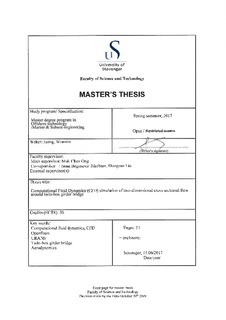| dc.contributor.advisor | Ong, Muk Chen | |
| dc.contributor.advisor | Liu, Shengnan | |
| dc.contributor.advisor | Jakobsen, Jasna Bogunovic | |
| dc.contributor.author | Jeong, Wonmin | |
| dc.coverage.spatial | Norway | nb_NO |
| dc.date.accessioned | 2017-10-18T11:19:35Z | |
| dc.date.available | 2017-10-18T11:19:35Z | |
| dc.date.issued | 2017-06-15 | |
| dc.identifier.uri | http://hdl.handle.net/11250/2460793 | |
| dc.description | Master's thesis in Offshore technology: Marine and subsea technology | nb_NO |
| dc.description.abstract | Flow around a twin-box bridge with a fixed spacing between the decks has been investigated using the two dimensional (2D) Unsteady Reynolds-Averaged Navier–Stokes (URANS) equations with the k–ω Shear Stress Transport (SST) turbulence model. Reynolds number (Re) based on the free stream velocity and the bridge deck height is about 31,000. Flow characteristics are studied in terms of the flow structures and physics in the range of angle of attack (AoA) -10.0° to +10.2°.
The objective of the present study is to evaluate the validity of 2D URANS simulations with k– ω SST model for the flow around the twin-box girder bridge. To provide insights for the better bridge design to reduce vortex induced vibration (VIV) in low wind speed, the present study provides CFD study results of aerodynamic factors, force variations and related aerodynamic parameters, for instance, drag coefficient, lift coefficient, moment coefficient and Strouhal number. The formation of the vortices also has been discussed to understand flow characteristic as a function of the angle of attack and how the vortex induced loading may be mitigated.
The drag coefficient, lift coefficient and moment coefficient show a good agreement with the wind tunnel experimental results in the range of AoA -10.0° to +10.2°, while the abrupt drop of the lift and moment coefficients are observed at AoA +10.2°. It is considered that the turbulence modelling is not good enough to capture the flow structure in this high AoA region due to the 3D flow effect.
The Strouhal number is also studied and reported for the engineering design reference purpose. No comparable experimental results are available, so further experimental results are required to validate the present study results.
In the meantime, the present study can useful an assessment tool for the design of bridges in earlier stage with arbitrary geometries, and for the evaluation of effectiveness of VIV reducing measures like railings, horizontal/vertical stabilizer and all the other arrangements. | nb_NO |
| dc.language.iso | eng | nb_NO |
| dc.publisher | University of Stavanger, Norway | nb_NO |
| dc.relation.ispartofseries | Masteroppgave/UIS-TN-IKM/2017; | |
| dc.subject | CFD | nb_NO |
| dc.subject | URANS | nb_NO |
| dc.subject | Openfoam | nb_NO |
| dc.subject | offshore technology | nb_NO |
| dc.subject | offshore teknologi | nb_NO |
| dc.subject | aerodynamics | nb_NO |
| dc.subject | twin-box girder bridge | nb_NO |
| dc.title | Computational Fluid Dynamics (CFD) simulation of two-dimensional(2D) cross sectional flow around twin-box girder bridge | nb_NO |
| dc.type | Master thesis | nb_NO |
| dc.subject.nsi | VDP::Technology: 500::Marine technology: 580::Offshore technology: 581 | nb_NO |
